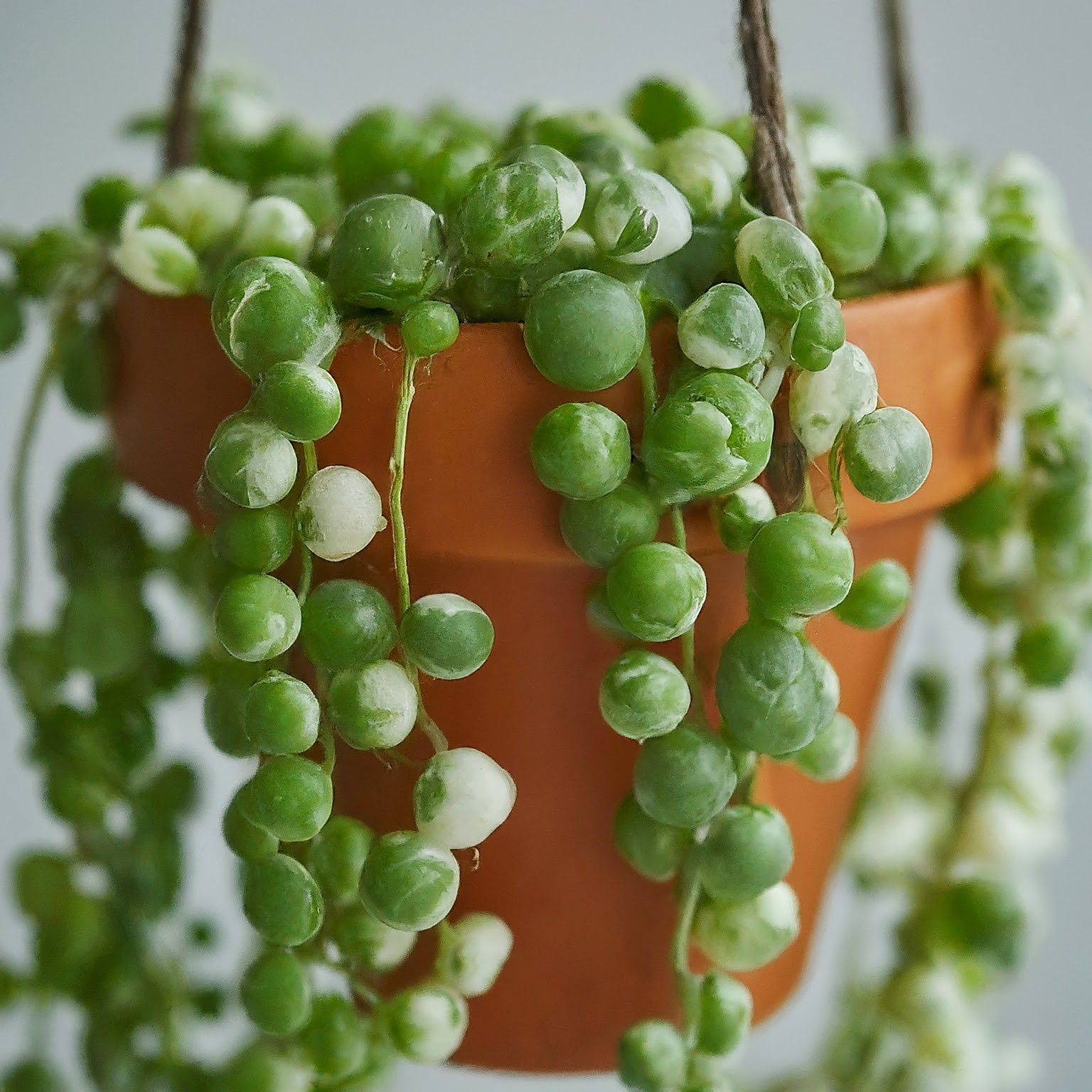The Variegated String of Pearls isn’t your average succulent. It features plump, pea-shaped pearls splashed with creamy white and sometimes a hint of blush. This plant’s cascading vines elegantly drape from pots or shelves, adding a touch of whimsy and undeniable charm to any indoor space.
But beyond the captivating looks, the Variegated String of Pearls (scientific name: Curio Rowleyanus ‘Variegated’) is a surprisingly low-maintenance plant, perfect for busy plant lovers or newbie gardeners.
But where do you even begin with a Variegated String of Pearls care?
This guide will walk you through all the steps to grow and care for this succulent. Plus, we’ll provide you with information about the origin and history of this indoor plant, its features, benefits, propagation techniques, and much more.
Jump to a section.
- Variegated String of Pearls Profile and Facts
- Variegated String of Pearls Features and Characteristics
- How to Grow Variegated String of Pearls
- Variegated String of Pearls Care
- Benefits of a Variegated String of Pearls
- Common Problems and Solutions for Variegated String of Pearls
- Companion Planting for Variegated String of Pearls
- How to Propagate Variegated String of Pearls
- How to Get a Variegated String of Pearls to Turn Pink?
- Conclusion
- FAQ
Variegated String of Pearls Profile and Facts
The Plant Whisperer’s Insight: Let’s meet the star of the show!
The Variegated String of Pearls or Senecio Rowleyanus ‘Variegated’ is a succulent native to South Africa.
It’s a close relative of the regular String of Pearls but with a stunning twist – variegated leaves! These add a touch of elegance and whimsy to its cascading growth habit.
Here’s a table with a rundown on the Variegated String of Pearls:
| Feature | Description |
| Botanical Name | Senecio rowleyanus ‘Variegated’ |
| Common Names | Variegated String of Pearls, Variegated Rosary Vine |
| Plant Type | Succulent |
| Origin | South Africa’s dry, coastal regions |
| Toxicity | Mildly toxic and can cause stomach upset if ingested. Keep out of reach of children and pets. |
| Light Preference | Bright, indirect sunlight (around 4-6 hours per day) |
| Light Requirements | Adequate bright, indirect sunlight is essential for optimal growth and maintaining variegation. |
| Light Issues | Insufficient light can cause variegation to fade and stems to become leggy. Too much direct sunlight can scorch the leaves. |
| Water Needs | Moderate, water deeply when soil dries completely |
| Watering Frequency | Water less frequently in winter months |
| Soil Preference | Well-draining succulent or cactus mix |
| Soil Amendments | Perlite or sand can be added for extra drainage |
| Temperature Range | 65°F – 80°F (18°C – 27°C) |
| Humidity Needs | Low humidity |
| Feeding | Balanced, diluted liquid fertilizer applied 1-2 times during growing season (spring/summer) |
| Repotting | Repot when roots outgrow pot or pot feels lightweight. Choose a pot only slightly larger than current one. |
| Mulching | Not recommended, can trap moisture and lead to rot. |
| Growth Habit | Trailing vine with cascading foliage |
| Growth Rate | Slow to moderate grower |
| Propagation | Stem cuttings |
| Special Features | Air purification, low maintenance, cascading charm |
| Lifespan | Can thrive and cascade beauty for many years with proper care. |
| Common Pests | Mealybugs, scale, aphids |
| Common Issue | Leaf rot due to overwatering |
| Dormancy | Not a true dormancy period, but growth slows in winter |
| Flowers | Small, daisy-like blooms (rarely appear) |
| Winter Care | Reduce watering, provide less light, and don’t fertilize |
| Best Container | Terracotta pot for better drainage |
| Companions | Other succulents, air plants, cacti |
Variegated String of Pearls Features and Characteristics
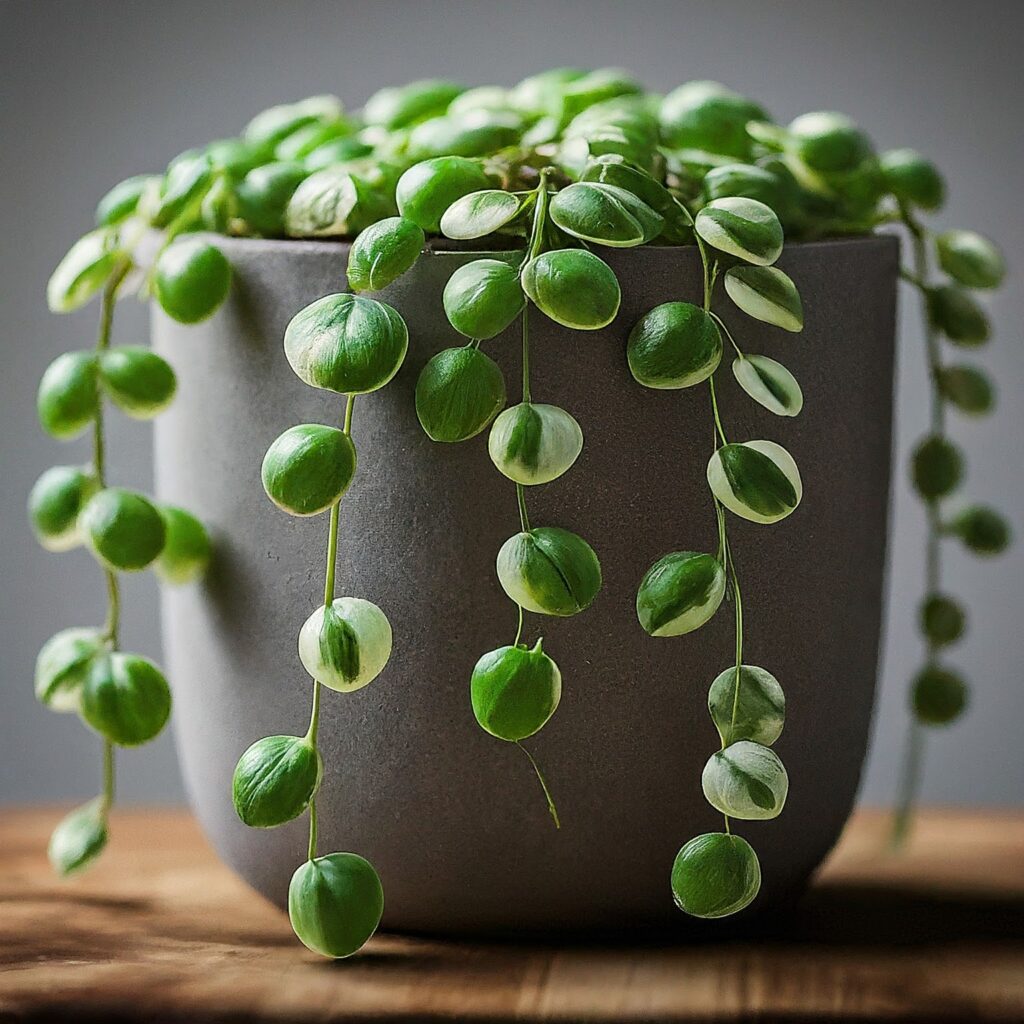
The magic of the Variegated String of Pearls lies in its unique features.
It showcases a string of plump, pea-shaped, green beads adorned with creamy white variegation. In some cases, these “pearls” might even boast a hint of pink, adding another layer of charm.
The fleshy leaves are connected by thin, wiry vines that can cascade beautifully from a hanging basket or drape over a shelf.
This gorgeous houseplant isn’t just about looks, though.
It’s a surprisingly low-maintenance succulent, perfect for busy plant lovers or those new to the succulent world. It thrives on neglect (within reason, of course!), making it a forgiving companion.
How to Grow Variegated String of Pearls
The Variegated String of Pearls isn’t just a looker, it’s surprisingly easy to grow!
With a few handy tips and the right approach, you can cultivate a thriving plant that will cascade beauty for years to come. Think of it as creating your own little piece of cascading elegance.
Below are the steps to grow your very own masterpiece:
Find a Variegated String of Pearls Plant
The first step is to find a healthy plant.
Here’s a breakdown of popular options to help you find a healthy and happy plant:
1. Local Nurseries
Your first option is to pay a visit to your local nurseries.
Why?
Because you get to see the plant in person before you buy it. Plus, you can inspect the overall health, variegation patterns, and size to ensure it meets your expectations.
The nursery staff can even provide information about the plant’s care history, especially watering frequency and light exposure. Make sure to look for established nurseries with a reputation for healthy succulents.
The selection of Variegated String of Pearls at a nursery might be more limited compared to online retailers. Be prepared to call ahead to check their stock.
2. Online Retailers
Online retailers offer a wider variety of the Variegated String of Pearls, including different sizes and pot options. You can conveniently browse selections from the comfort of your home.
Order from reputable online retailers with experience shipping succulents while also looking for detailed descriptions and high-quality photos of the plants. It is a good idea to read customer reviews to gauge the seller’s reliability.
Remember that shipping costs can add up, especially for larger plants. Also, you won’t be able to inspect the plant in person before purchasing.
3. Plant Swap Events
Plant swap events are a fantastic way to connect with fellow plant enthusiasts, score unique finds, and may even find a Variegated String of Pearls cutting.
Be sure to ask about watering habits, light exposure, and any potential pest or disease issues. Inspect the cutting for signs of good health, like plump leaves and firm stems.
Planting Your Variegated String of Pearls
Once you’ve found your ideal Variegated String of Pearls, it’s time to plant it in a perfect environment where it can thrive.
Here are the key elements to consider:
Light is Life
Bright, indirect sunlight is the golden rule.
Give your variegated string of pearls 4-6 hours of bright, indirect sunlight each day. Think of it as mimicking a spot bathed in dappled sunlight filtering through leaves
South-facing windows with sheer curtains or east-facing windows can provide the perfect amount of illumination.
However, avoid harsh, direct sunlight, as it can scorch the delicate leaves. Signs of insufficient light include leggy growth with sparse foliage and fading variegation.
Pot With Drainage in Mind
Plant your Variegated String of Pearls in a pot with drainage holes to prevent waterlogging, which is the enemy of your Variegated String of Pearls. Terracotta pots are excellent choices because they allow for better airflow and evaporation of excess moisture.
When choosing a pot size, opt for one that’s only slightly larger than the root ball of your plant. Upsizing too quickly can trap moisture around the roots and lead to rot.
The Right Soil Mix
Drainage is key, so use a well-draining succulent or cactus mix.
You can even create your own by mixing regular potting mix with perlite or coarse sand in a 50/50 ratio for added drainage. Avoid using soil that retains too much moisture, as this can suffocate the roots.
Variegated String of Pearls Care
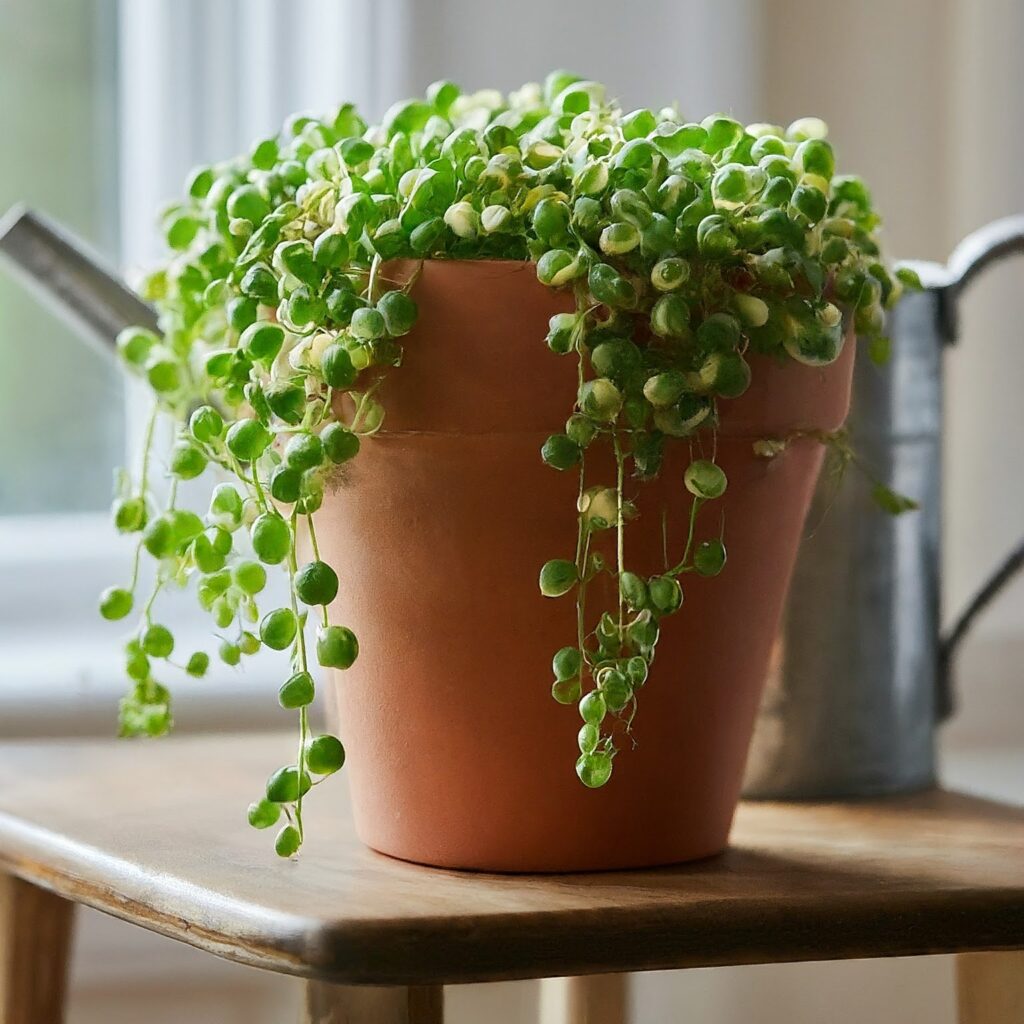
The real work begins after your plant has settled in its new home. Here’s everything you want to know about the Variegated String of Pearls care!
Watering
Think underwatering rather than overwatering!
Remember, this succulent comes from a dry climate. Soggy soil is the enemy, so err on the side of caution.
Stick your finger in the soil! When it feels completely dry to the touch, that’s a sign your Variegated String of Pearls needs deep watering.
During the winter months, you can water even less frequently.
Feeling unsure? Here’s a trick: Pick up your pot. Does it feel lightweight? That’s your cue to water!
Temperature and Humidity
Mimic the warm, dry conditions of South Africa. This plant thrives in temperatures between 65°F and 80°F (18°C – 27°C).
Luckily, most homes fall within this range.
Humidity isn’t a major concern for this plant. In fact, it flourishes in dry air, making it a perfect choice for those living in drier climates.
Feeding
The Variegated String of Pearls isn’t a heavy feeder.
A balanced, diluted liquid fertilizer applied once or twice during the growing season (spring and summer) is sufficient.
Feeling adventurous? Consider creating your own homemade nitrogen fertilizer for your plant.
Repotting
This isn’t a fast-growing succulent, so repotting won’t be necessary too often.
Signs that your plant needs a new home include roots poking out of the drainage holes or the pot feeling excessively lightweight.
When repotting, choose a pot that’s only slightly larger than the current one.
Mulching
Mulching isn’t necessary for the Variegated String of Pearls. In fact, it can trap moisture around the base of
Deadheading
While the Variegated String of Pearls doesn’t produce flamboyant flowers, you might occasionally notice a single, daisy-like bloom appear. These are pretty but not essential to the plant’s health.
Feel free to deadhead (remove) spent blooms to encourage bushier growth.
Winter Care
During winter, growth slows down. Reduce watering even further, allowing the soil to dry out completely between waterings. You can also give your plant a bit less light during this time.
Don’t fertilize during winter.
Dividing and Pruning
The Variegated String of Pearls can get leggy over time, with bare stems at the base.
- Dividing: If your plant has become too large or unruly, you can divide it into multiple plants. Simply unpot the plant and gently tease apart the roots and stems. Repot each section in its own pot with fresh succulent mix.
- Pruning: To encourage bushier growth and fill out bare spots, pruning your string of pearls is a good option. Snip off leggy stems just above a healthy leaf node. You can even propagate these cuttings to create new plants!
Benefits of a Variegated String of Pearls
Here’s more than just one reason to add this whimsical succulent to your collection:
- Air Purification: Like most succulents, the Variegated String of Pearls helps purify the air by removing common toxins.
- Low Maintenance: This is a perfect plant for busy schedules or those new to the world of succulents. Its forgiving nature allows for some neglect.
- Cascading Charm: The trailing vines add a touch of whimsy and elegance to any space. Hang it in a basket or let it drape over a shelf for a dramatic effect.
- Conversation Starter: This unique succulent is bound to grab attention, so be prepared to answer questions about its captivating appearance!
Common Problems and Solutions for Variegated String of Pearls
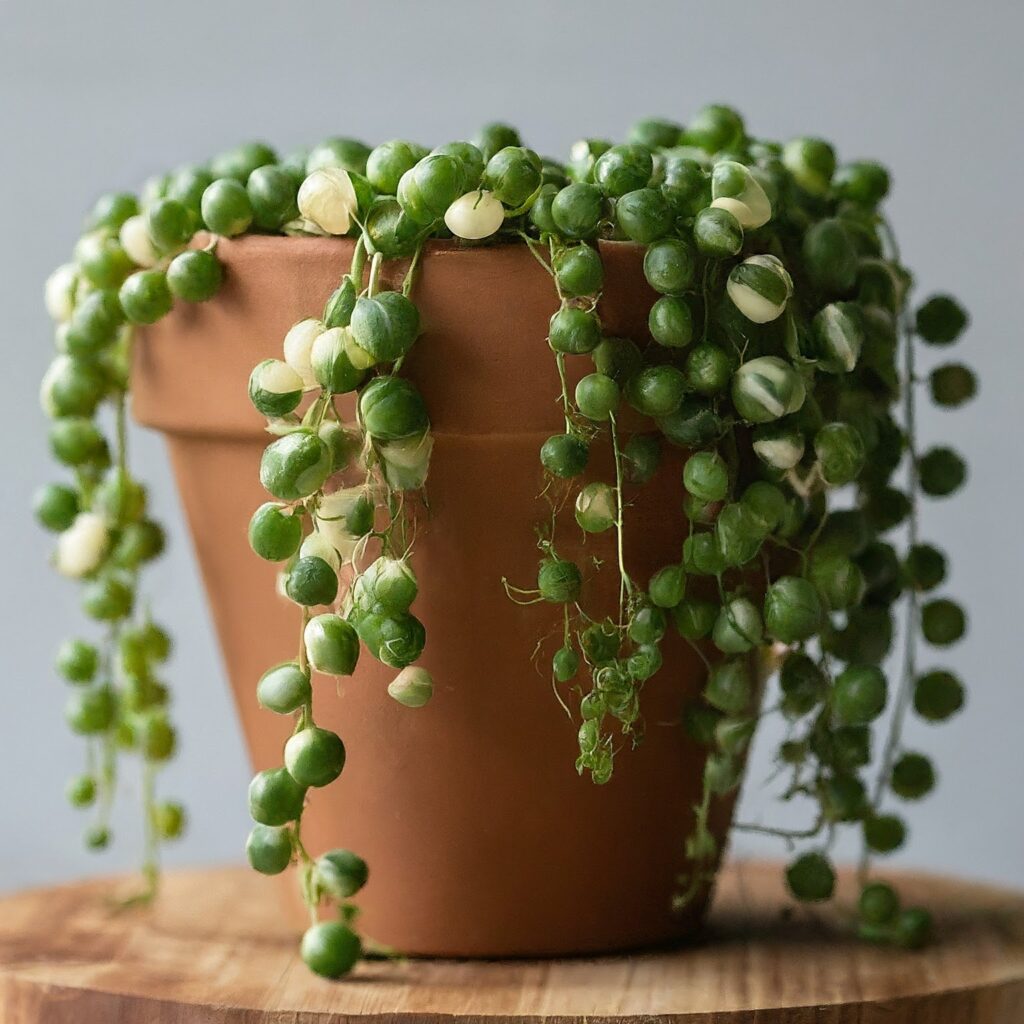
Even the most low-maintenance plant can face occasional challenges.
Here’s how to tackle some common issues with your Variegated String of Pearls:
- Beads on the stems turning translucent or soft: This is a classic sign of overwatering. Allow the soil to dry out completely between waterings and adjust your watering frequency accordingly. Remove any mushy beads and stems to prevent rot.
- Yellow or brown with drooping leaves: This could be due to underwatering or excessive sunlight. Check the soil moisture. If dry, water deeply. If the plant receives too much direct sunlight, move it to a location with brighter indirect light.
- The plant is Shriveling Up: Underwatering is the culprit here. Give your plant a thorough drink and adjust your watering schedule.
- Leaf Rot: This is caused by prolonged dampness around the leaves. Ensure proper drainage and avoid overwatering. Plus, try to improve air circulation around the plant.
- Whole plant drying: This is most likely due to underwatering, especially during the summer months. Check the soil. If it is completely dry, water your plant deeply.
Pest and Disease Control
Thankfully, the Variegated String of Pearls isn’t particularly prone to pests or diseases.
However, keep an eye out for mealybugs, aphids, and scales, which can appear as white, cottony patches or small bumps on the leaves.
If you see unwelcome guests, an insecticidal soap or neem oil spray can be a gentle yet effective solution. Also, consider DIY pest control methods to save your plants without using harsh chemicals.
Companion Planting for Variegated String of Pearls
While the Variegated String of Pearls can hold its own as a stunning solo act, it can also play well with others.
Here are some ideas for companion planting:
- Other Succulents: Pair your string of pearls with other succulents with similar light and watering needs, like jade plants, aloe vera, or haworthia.
- Air Plants: These low-maintenance plants don’t require soil and can be tucked in amongst the cascading vines of the string of pearls for a unique look.
- Cacti: Cacti share similar care requirements and can create a visually interesting desert-inspired arrangement.
How to Propagate Variegated String of Pearls
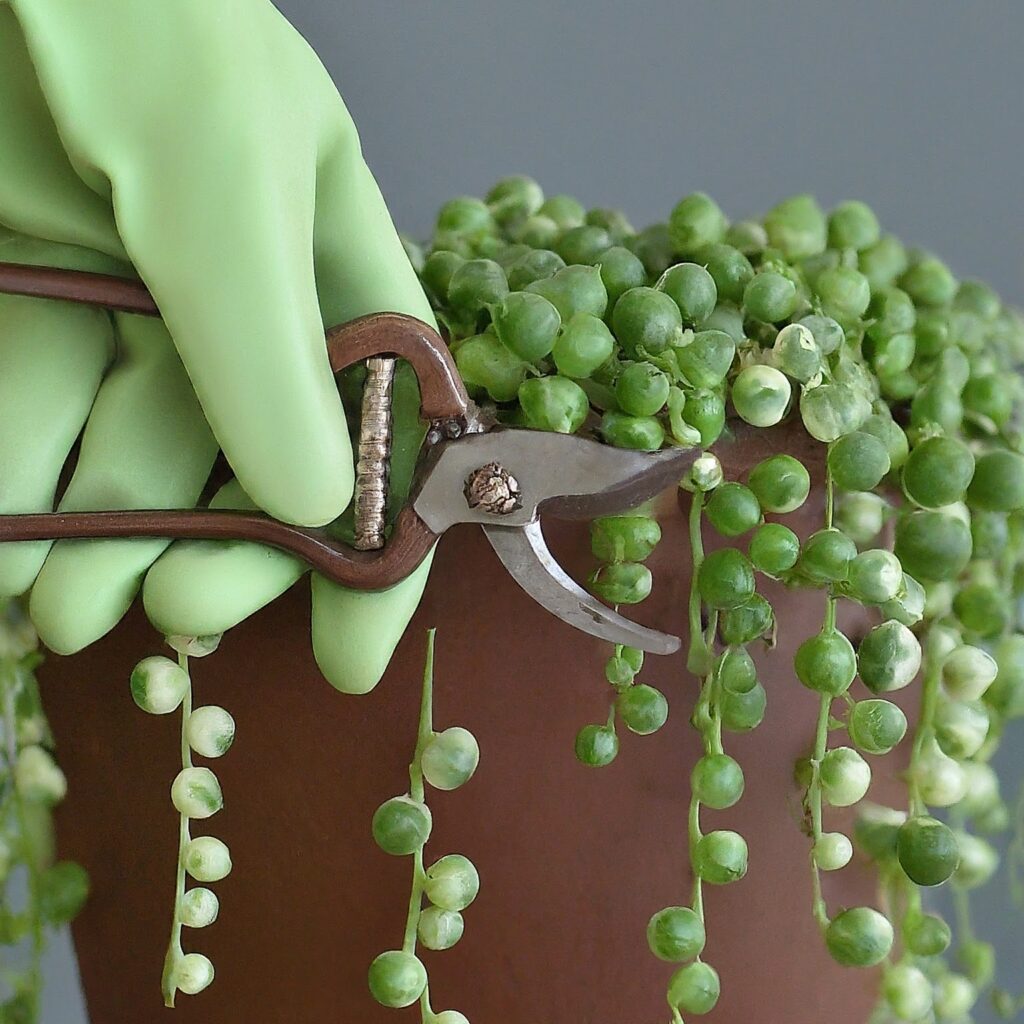
The beauty of the Variegated String of Pearls is that it’s easy to propagate, allowing you to create more plants for yourself or share with friends.
Here are the different methods of Variegated String of Pearls propagation.
Propagating Variegated String of Pearls From Pearls? (Not Recommended)
Unfortunately, propagating directly from individual “pearls” isn’t recommended. These plump leaves lack the necessary nodes where roots can develop. While some claim success with this method, it’s a much slower and less reliable approach.
Propagation via Stem Cuttings
This is the tried-and-true method for propagating a Variegated String of Pearls.
Here are the steps to propagate Variegated String of Pearls from stem cuttings:
- Gather your tools: You’ll need sharp shears, a pot with drainage holes, a well-draining succulent or cactus mix, and a pencil or chopstick.
- Select your cuttings: Choose healthy stems with several plump leaves. Ideally, aim for cuttings that are 2-4 inches long.
- Prepare the cuttings: Using your sharp shears, make a clean cut just below a leaf node. You can remove the bottom pair of leaves to expose more stems for rooting.
- Let the cuttings callus over: This is an important step that allows the cut end to dry out and form a callus, preventing rot. Leave the cuttings on a dry surface in indirect light for a day or two.
- Planting the cuttings: Fill your pot with the succulent mix. Make a hole in the soil using your pencil or chopstick, then insert the calloused end of the cutting about an inch deep. Gently press the soil around the cutting to provide support and encourage root growth.
- Watering and care: Water the soil lightly after planting and then put the pot in a spot with bright, indirect sunlight.
- Be patient: Rooting can take several weeks. Be patient and avoid overwatering. You’ll see new growth sprouting from the base of the cutting once roots have established.
How to Get a Variegated String of Pearls to Turn Pink?

The pink variegation on the “pearls” of your string of pearls is a delightful bonus, but it’s not always guaranteed.
Here are some factors that can influence the pink coloration:
- Light: The more intense, indirect sunlight your plant receives, the more likely it is to develop pink variegation. However, be careful not to expose it to harsh, direct sunlight, which can scorch the leaves.
- Stress: A little stress can actually encourage pink variegation. This doesn’t mean neglecting your plant entirely! However, allowing the soil to dry out slightly between waterings can sometimes trigger a stress response and promote pink coloration.
- Genetics: The truth is, some variegated strings of pearls are simply more predisposed to developing pink variegation than others.
Conclusion
The Variegated String of Pearls is a captivating succulent that offers a unique combination of beauty and ease of care. With a little knowledge and these helpful tips, you can cultivate a thriving plant that will add a touch of whimsy and elegance to your indoor space.
Remember, gardening is a journey, and there will be successes and setbacks along the way. Enjoy the process of watching your Variegated String of Pearls flourish, and don’t hesitate to experiment and learn from any challenges that arise.
FAQ
Is Variegated String of Pearls rare?
The Variegated String of Pearls isn’t necessarily rare, but it might not be as readily available as its green counterpart.
However, with a little searching at plant nurseries, online retailers, or plant swap events, you should be able to find your own little piece of cascading magic.
Do variegated strings of pearls revert?
Yes, variegated strings of pearls can revert to their green form, especially if they don’t receive enough light. Ensure your plant gets plenty of bright, indirect sunlight to maintain the beautiful variegation.
Are all variegated strings of hearts pink?
No, not all Variegated String of Pearls have pink variegation. While some may develop stunning pink accents, others might showcase primarily white variegation.
Both variations are equally beautiful!
Why is my Variegated String of Pearls turning purple?
While less common, a Variegated String of Pearls exposed to cold temperatures for extended periods might develop a slight purple tinge on the leaves. If this happens, bring your plant indoors to a warmer location.
Why is my String of Pearls losing color?
There are a couple of reasons why your string of pearls might be losing color. Inadequate light can lead to loss of variegation.
Plus, overwatering can stress the plant, leading to discoloring. Ensure your plant receives enough light and water only when the soil dries out completely.
Is Variegated String of Pearls toxic to pets and humans?
- For Pets: If your furry friend or curious critter ingests parts of the plant, they might experience symptoms like vomiting, diarrhea, abdominal pain, or irritation of the mouth.
- For Humans: Ingestion by humans can also lead to stomach upset, nausea, or vomiting.
Thankfully, serious harm is uncommon. However, it’s still important to keep the plant out of reach of children and pets to avoid any potential problems.
